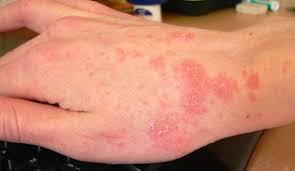POISON IVY

What is Poison Ivy?
Poison Ivy is an allergic contact dermatitis that is caused by exposure to the allergenic component urushiol found in poison ivy, poison oak, and poison sumac. There are three ways to get this rash. Either direct contact with the plant, indirectly by touching an object which has touched urushiol (pets fur, gardening tool), or airborne spread by burning the plants releasing the allergen into the environment for potential skin contact. The common phrase “leaves of three, let them be” is a way to identify the plant that should be avoided. However, there is seasonal, growth, and regional variation on using this rule as a way for identification.
What does the rash look like and what are the symptoms?
Intense itching and redness are the most common presenting signs of poison ivy dermatitis. The rash manifests as papules, vesicles and/or bullae, often arranged in a linear or streak-like configuration where a portion of the plant has contacted the skin.
What is the treatment?
Treatment consists of topical symptomatic therapies including oatmeal baths, cool compresses, and topical glucocorticoids. Oral antihistamines may provide some relief from itching and can also be used for their sedative effects.


